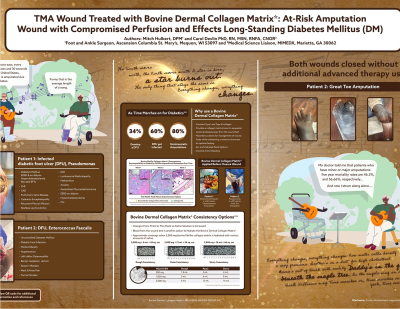Case Series/Study
(CS-065) TMA Wound Treated with Bovine Dermal Collagen Matrix*: At-risk Amputation Wound with Compromised Perfusion and Effects Long-standing Diabetes

The average length of a song is approximately three to four minutes. According to the American Diabetes Association1, “Every 3 minutes and 30 seconds in the United States, a limb is amputated due to diabetes.” Patients with diabetic foot ulcers represent 80% of nontraumatic amputations.2 Typically, these patients have impaired foot perfusion and high wound complication rates including surgical site infection rates as high as 63.2%.3 Surgical site infections represent to most costly hospital acquired infection.4 Patients who undergo minor or major amputations five year mortality rates are 46.2% and 56.66%, respectively.5
Advanced modalities to support surgical wound closure are needed in this fragile patient population. We submit a transmetatarsal amputation case where a Bovine Dermal Collagen Matrix*, which is intended for the management of moderately to heavily exudating wounds, to control minor bleeding and to support wound closure, was applied.
Methods:
A 69-year-old polymorbid male, with longstanding type 2 diabetes, presented with an infected diabetic foot ulcer and impaired arterial perfusion. Cultures identified Enterococcus Faecalis which was treated with antibiotics. A transmetatarsal amputation was performed and a Bovine Dermal Collagen Matrix* was applied to the irregularities of the transmetatarsal amputation surgical wound.
Results:
The transmetatarsal amputation wound closed without complication or additional advanced therapy use.
Discussion:
Proactively addressing high risk surgical wounds may benefit patients and avoid the costs associated with surgical wound complications. This foundational evidence is important in the evaluation of adjunctive product use in high-risk surgical wounds such as Bovine Dermal Collagen Matrix*

.jpg)